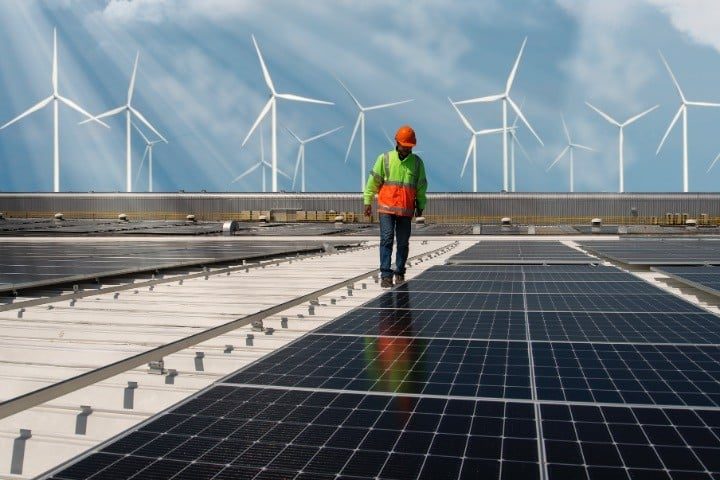
The final article in this series will address the environmental issues associated with U.S. wind turbine, solar panel, and battery energy storage system installations proposed for transitioning to a renewable energy economy.
Wind Turbine Issues
Generating all of America’s power currently provided by fossil fuel and nuclear power (> 8 billion megawatt-hours) with wind energy would require 2.12 million turbines on 500,682 square miles of farm, wildlife habitat, and scenic lands. This land area is equivalent to the states of Arizona, California, Nevada, Oregon, and West Virginia combined, according to the policy brief Protecting the Environment from the Green New Deal published in 2019 by The Heartland Institute.
Many wind turbine projects invariably encounter the NIMBY response (not in my backyard) from potential neighbors, especially wealthy neighbors. Wind turbines create noise pollution, both audible and inaudible low-frequency noise, which can cause sleep disturbance and headaches in humans. Wind projects are invariably targeted for low-income counties where opponents don’t have as much money to fight back.
There are significant environmental costs associated with mining and refining rare earth elements for wind turbines. For example, writing for MIT News in his article “Clean Energy Could Lead to Scarce Materials,” D.L. Chandler explains that approximately one ton of neodymium magnets is needed for each 5-MW wind turbine. And processing of rare earth elements creates a radioactive waste byproduct.
Preparation of land for many wind farms does extensive environmental damage, often necessitating removal of thousands of trees and bulldozing of hills and valleys. Since 2015, from Maine to Hawaii, there have been more than 300 rejections or restrictions of wind projects, relates Robert Bryce in “Here’s the List of 317 Wind Energy Rejections the Sierra Club Doesn’t Want You to See” for Forbes.
Actual electricity output is rarely as advertised, often hitting 20 percent or lower depending on location (according to the Centre for Sustainable Energy’s “Common Concerns about Wind Power”) — and failing completely on the hottest and coldest days when electricity is most urgently needed. Electricity output declines by 16 percent per decade of operation — and worse than that offshore because of storms and salt spray — says the Renewable Energy Foundation in “The Performance of Wind Farms in the United Kingdom and Denmark.”
Environment & Climate News explains in “States, Localities Face High Wind Turbine Decommissioning Costs” that wind turbine lifetime is about 10 years for offshore turbines, about 20 years for onshore turbines.
Solar Panel Issues
Generating all of America’s power currently provided by fossil fuel and nuclear power (> 8 billion megawatt-hours) with solar energy would require 18.7 billion solar panels on 57,024 square miles of land. This land area is equivalent to the states of New York and Vermont combined, says The Heartland Institute.
Solar panels and their manufacturing processes necessitate many toxic chemicals, including lead, cadmium telluride, copper indium selenide, cadmium gallium (di)selenide, copper indium gallium (di)selenide, hexafluoroethane, and polyvinyl fluoride, according to David Nguyen writing for Sciencing in his 2019 article “Toxic Chemicals in Solar Panels.” Incredibly, these processes generate 300 times more toxic waste per unit of energy than nuclear power plants, per Jemin Desai and Mark Nelson in “Are We Headed for a Solar Waste Crisis?,” published in Environmental Progress News.
The Intergovernmental Panel on Climate Change (IPCC) deems toxic nitrogen trifluoride (NF3), used in some solar panel construction, to be over 17,000 times more potent than CO2 as a greenhouse gas, as recorded by the University of California at San Diego News Center in “Potent Greenhouse Gas More Prevalent in Atmosphere than Previously Assumed.”
Solar panels last about 25 years, according to the Journal of Energy Research and Reviews’ “On the Ability of Wind and Solar Electric Generation to Power Modern Civilization,” but high temperatures can accelerate the aging process for solar cells, and snow, dust, and other natural events can cause material fatigue on the surface and in internal electric circuits — gradually reducing a panel’s power output.
The International Renewable Energy Agency estimates that by 2050, up to 78 million tons of solar panels will have reached the end of their life and the world will create another six million tons of photovoltaic waste every year. Disposal of solar panels in landfills is not appropriate as they contain toxic materials, and the cost of recycled materials is significantly more than the raw material cost. Currently, U.S. solar panel manufacturers are not even required to, and do not, collect and dispose of solar panel manufacturing toxic waste.
Battery Energy Storage System Issues
There is an almost complete disconnect between current efforts of small research grants and pilot programs to investigate which of various new energy storage technologies might work in a 100-percent renewables scenario and a multi-hundred-trillion-dollar total transformation of the entire energy economy that will supposedly be accomplished by 2035 using technology not yet invented, let alone demonstrated at scale. The topic is explored in Francis Menton’s 2022 “Report on the Status of the U.S. Energy Storage Project.” Additionally, the real battery issues associated with a 100-percent renewables grid have yet to be seriously addressed.
Backup batteries are generally proposed as the solution to the intermittency problem of solar and wind energy. Batteries are not electricity generators — they have to be recharged constantly, and the mechanism for charging them is the very solar and wind generators whose intermittency causes the energy deficiency in the first place. The off-grid system must be designed to provide a charge current capable of recharging batteries quickly and efficiently, and within the window of time the on-grid system is generating peak power. And battery energy storage systems generally can’t sustain output for more than several hours, at best.
Backup battery storage requirements for the electricity demands of the entire U.S. would be absolutely staggering. Issues not being addressed include:
- How many batteries would be required to provide adequate backup electricity to the “green” grid when parts of the U.S. experience extended wind and sun downtimes?
- Do sufficient raw materials even exist?
- How would we dispose of huge amounts of toxic waste from battery manufacturing?
Lithium batteries contain both oxidizers and fuel within the enclosed battery space, and therefore carry risk of fire and explosion in case of overcharging, over-discharging, excess current, or short circuits. Currently there is no single standard or parameter for assessing battery safety and no fire-prevention system design standards or test criteria for battery energy storage systems.
At the scale necessary to supplement on-demand “renewable” generated electricity, the cost of backup battery storage systems makes anything even close to 100 percent renewables economically impossible, according to the February 2020 edition of Environment & Climate News.
The obvious rational conclusion to be drawn from this series of articles is that believing existing solar, wind, and energy storage technologies make possible a rapid and wholesale replacement of fossil fuels ignores the underlying physics, engineering, and economics. The only serious discussion with respect to replacing fossil fuels for electricity generation is nuclear energy, without which there will never be enough electricity to support an all-electric vehicle transportation system. And a 100-percent renewables economy is not even remotely possible.
Other articles in this series:
Back to Energy’s Future? — Part 1
Back to Energy’s Future? — Part 2
Back to Energy’s Future? — Part 3
Back to Energy’s Future? — Part 4
Back to Energy’s Future? — Part 5
Back to Energy’s Future? — Part 6




